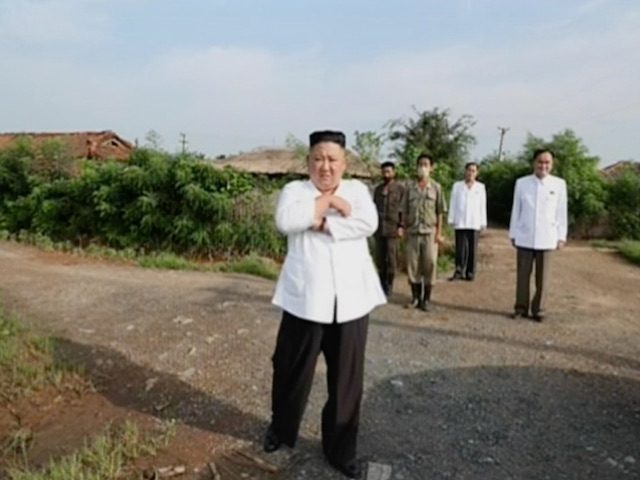North Korean state television published photos allegedly of communist dictator Kim Jong-un visiting North Hwanghae Province on Friday, following devastating floods in the area.
Heavy rains have tormented much of east Asia for over a month, particularly damaging the Chinese heartland. Of China’s 31 provinces, 27 have experienced the highest water levels in half a century, resulting in over 100 deaths and disappearances and significant destruction of infrastructure. Chinese state media has confirmed that the rains have deformed the Three Gorges Dam, the world’s largest hydroelectric plant, located on the Yangtze River.
The Korean Peninsula has faced heavy rains all week, following the landfall of typhoon Hagupit, resulting in thousands of evacuations in South Korea and at least 13 deaths. North Korea bans all non-government media from operating in the country and punishes any activity deemed subversive with multiple generations of hard labor or death, so the outside world has no reliable calculations for the damage done in that country.
Although China has faced flood-driven devastation for many more weeks than North Korea, Kim Jong-un beat Chinese dictator Xi Jinping to visiting the affected areas in their respective countries. Xi has yet to tour any damaged site or offer condolences to the victims of the flooding at press time.
The Korean Central News Agency (KCNA), North Korea’s state-run newswire service, did not specify when Kim visited North Hwanghae Province, but noted that the damage he was touring was recent.
“Due to several consecutive days of torrential rain and rainstorm recently caused by the seasonal rainy front, the waterway levee gave way in the area of Taechong-ri of Unpha County, leaving more than 730 single-floored houses and 600-odd hectares of rice field inundated and 179 blocks of dwelling houses destroyed,” KCNA noted. Kim reportedly “personally went to the spot to learn about the situation and clarified tasks and ways in detail for the recovery of the damaged area.”
Images broadcast on the television equivalent of KCNA showed vast fields of what appeared to be growing crops completely underwater, as well as buildings showing significant structural damage. In some photos, Kim stood speaking with individuals who appeared to be local officials. Those in the photos did not appear to be wearing masks, but did seem to be keeping a distance. KCNA has been publishing a high volume of content warning North Koreans to participate in the national battle against the Chinese coronavirus pandemic, although North Korean officials insist they have documented zero cases of the virus there.
Kim used his visit to call “on leading organs in the county including Party and power organs, working people’s organizations and public security organs to responsibly conduct the work of putting up the residents who lost their homes at [sic] offices,” according to KCNA. Kim also allegedly pressured local officials to make sure the victims of the floods did not starve.
South Korea’s Yonhap news agency reported that about 900 homes in the site Kim toured had been completely flooded and rendered uninhabitable. The agency noted that the heavy rains in the area began on Tuesday, making Thursday the likeliest time for Kim’s visit.
“Nearly 730 homes and 600 hectares of rice fields have been flooded and 179 homes destroyed after a levee broke as heavy rainfall pounded the country for days, but no casualties were reported, according to the KCNA,” Yonhap relayed.
Meteorologists in the country predicted last week that North Korea would receive as much as 20 inches of rain this week.
In neighboring China, floods have been ravaging major cities, key industrial sites, and extensive rural territories since late June, but Xi has not visited any of the affected areas as of Friday. In June, when the rains began, Xi organized a bureaucratic meeting from Beijing, which has remained relatively unaffected, in which he urged his underlings to “put people first, and value people’s lives most in the combat against floods,” according to the state-run Xinhua news agency.
Xi held a meeting in Beijing in July in which he admitted the situation in the center of the country, along the Yangtze’s path across the country, was “grim.”
“Xi Jinping on Friday urged local governments and Party members to take responsibility in flood-triggered disaster prevention and relief work as large parts of China were reeling from the worst floods in decades,” Chinese state-run network CGTN reported in July.
Xi urged lower-ranking communists to “brave the challenges” of controlling floods but did not extend sympathies to those struggling to protect their homes. China has held no national events to honor the dead or missing.
On Thursday, Xi again issued remarks but failed to mention the floods entirely.
“Xi Jinping has underlined the need to combine top-level design and public opinions in compiling the 14th Five-Year Plan,” Xinhua reported, referring to one of a near-interminable list of vaguely worded Communist Party proposals to march towards national prosperity.
“China will implement the 14th Five-Year Plan for Economic and Social Development starting next year,” Xinhua claimed. “As the compiling work is going on, relevant departments will soon solicit opinions and suggestions from officials, the public, as well as the specialists and scholars.”
As of this week, Chinese media estimates that over 38 million people in China have been affected in someway by the ongoing floods, though some estimates suggest that number may be as high as 50 million.

COMMENTS
Please let us know if you're having issues with commenting.